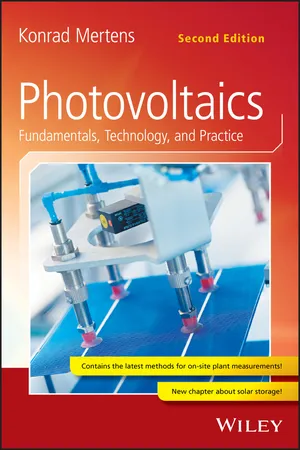
- English
- ePUB (mobile friendly)
- Available on iOS & Android
About this book
A comprehensive tutorial on photovoltaic technology now fully updated to include solar storage and the latest methods for on-site plant measurements
Starting with the basic principles of solar energy, this fully updated, practical text explains the fundamentals of semiconductor physics and the structure and functioning of the solar cell. It describes the latest measurement techniques for solar modules, and the planning and operation of grid-connected and off-grid PV systems.
It also looks at other thin film cells, hybrid wafer cells, and concentrator systems. Additionally, this Second Edition covers solar modules and solar generators; system technology of grid connected plants; the storage of solar energy; photovoltaic measurement technology; the planning and operation of grid-connected systems; economic efficiency of PV systems; and the future development of PV.
- Presents the latest advances in PV R&D and industry deployment
- Updated illustrations and tabular data reflect current state-of-the-art and PV technology efficiencies
- Offers expanded tutorial sections to aid teaching and self-study
- Includes a brand-new chapter on Solar Energy Storage
- Features two enlarged chapters—one on up-to-date photovoltaic metrology and the other on the future developments in photovoltaics
- Comes along with the accompanying website www.textbook-pv.org which offers free downloadable figures of the book, solutions of exercises, additional free PV software etc.
Developed to prepare engineering students for the PV industry, this practical text is an essential PV primer.
Frequently asked questions
- Essential is ideal for learners and professionals who enjoy exploring a wide range of subjects. Access the Essential Library with 800,000+ trusted titles and best-sellers across business, personal growth, and the humanities. Includes unlimited reading time and Standard Read Aloud voice.
- Complete: Perfect for advanced learners and researchers needing full, unrestricted access. Unlock 1.4M+ books across hundreds of subjects, including academic and specialized titles. The Complete Plan also includes advanced features like Premium Read Aloud and Research Assistant.
Please note we cannot support devices running on iOS 13 and Android 7 or earlier. Learn more about using the app.
Information
1
Introduction
1.1 Introduction
1.1.1 Why Photovoltaics?
1.1.2 Who Should Read This Book?
1.1.3 Structure of the Book
Table of contents
- Cover
- Table of Contents
- Preface to the First International Edition
- Preface to the Second International Edition
- Abbreviations
- Chapter 1: Introduction
- Chapter 2: Solar Radiation
- Chapter 3: Fundamentals of Semiconductor Physics
- 4 Structure and Method of Operation of Solar Cells
- Chapter 5: Cell Technologies
- Chapter 6: Solar Modules and Solar Generators
- Chapter 7: System Technology of Grid‐connected Plants
- Chapter 8: Storage of Solar Energy
- Chapter 9: Photovoltaic Metrology
- Chapter 10: Design and Operation of Grid‐connected Plants
- Chapter 11: Future Development
- Chapter 12: Exercises
- Appendix A: Solar Radiation Diagrams
- Appendix B: Checklist for Planning, Installing, and Operating a Photovoltaic Plant
- Appendix C: Physical Constants/Material Parameters
- References
- Further Information on Photovoltaics
- Index
- End User License Agreement